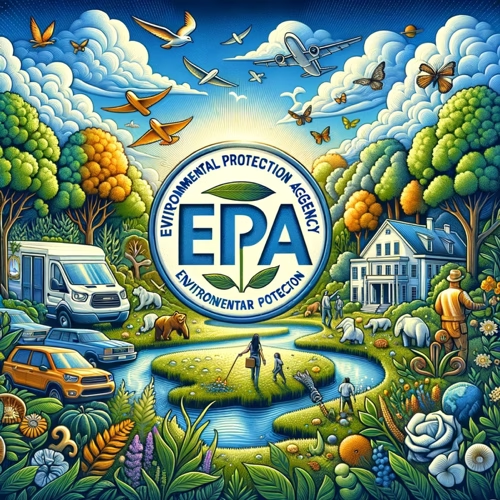Bra podd
Sveriges mest populära poddar

Environmental Protection Agency (EPA) News
EPA Shakes Up Renewables and Energy Policy - Biofuel Targets Soar, Coal Plants Spared
4 min • 18 juni 2025
The biggest headline from the EPA this week is its push to reshape the country’s energy landscape with sweeping changes to the Renewable Fuel Standard. On June 13, the EPA proposed ambitious new biofuel targets for 2026 and 2027, marking the 20th anniversary of the RFS program and promising the highest-ever requirements for renewable fuels in the U.S. This move, according to EPA Administrator Lee Zeldin, “creates a new system that benefits American farmers while mitigating the impact on gas prices and ensuring the continued existence of liquid fuels.” Secretary of Agriculture Brooke Rollins added, “This is the boldest proposal ever and sends a strong signal that American producers are a driving force in our energy future.” These new standards will raise the total renewable fuel requirement to 24.46 billion RINs by 2027, with significant expansions for cellulosic biofuels and advanced biofuels. Notably, EPA is tightening rules for imported renewable fuels and eliminating credits for renewable electricity, signaling a shift toward homegrown solutions and away from foreign dependence.
This announcement stands alongside another major regulatory pivot: EPA is proposing to repeal Biden-era greenhouse gas emissions standards for power plants, which the agency argues will save Americans more than a billion dollars annually by lowering utility bills and preventing coal and gas power plant closures. Administrator Zeldin, joined by lawmakers and tribal leaders, said the move will “restore American energy dominance and break down barriers to affordable, dependable energy.”
On chemicals and environmental safety, the EPA just extended reporting deadlines for manufacturers of certain high-risk substances, including PFAS, giving small importers until 2027 to comply. The agency also released draft risk evaluations for two plasticizers—DBP and DEHP—finding that they present unreasonable risks to human health and the environment. Public comments on these evaluations are open through August 4, and peer review meetings will follow.
For Americans, these changes mean potential relief at the pump, more stable energy prices, and continued support for rural economies and the biofuel sector. Businesses, especially in energy and agriculture, will need to adapt to new compliance timelines and investment signals. State and local governments could see changes in energy project funding and regulatory enforcement. Internationally, the EPA’s stance aims to boost U.S. ethanol exports and energy independence, exemplified by a recent deal granting $700 million in tariff-free ethanol exports to the UK.
Looking ahead, citizens can engage by submitting comments on the draft chemical risk evaluations and the proposed biofuel standards. The window for feedback on the RFS proposal is open, and those wishing to influence the direction of America’s energy policy or chemical safety can do so through the EPA’s public docket. For updates, visit the EPA’s website, and if you care about how the country powers up, now’s the time to make your voice heard. Watch for final decisions on the RFS rule later this year and peer review outcomes on chemical safety in August. Stay informed, stay engaged, and help shape the future of environmental policy.
This announcement stands alongside another major regulatory pivot: EPA is proposing to repeal Biden-era greenhouse gas emissions standards for power plants, which the agency argues will save Americans more than a billion dollars annually by lowering utility bills and preventing coal and gas power plant closures. Administrator Zeldin, joined by lawmakers and tribal leaders, said the move will “restore American energy dominance and break down barriers to affordable, dependable energy.”
On chemicals and environmental safety, the EPA just extended reporting deadlines for manufacturers of certain high-risk substances, including PFAS, giving small importers until 2027 to comply. The agency also released draft risk evaluations for two plasticizers—DBP and DEHP—finding that they present unreasonable risks to human health and the environment. Public comments on these evaluations are open through August 4, and peer review meetings will follow.
For Americans, these changes mean potential relief at the pump, more stable energy prices, and continued support for rural economies and the biofuel sector. Businesses, especially in energy and agriculture, will need to adapt to new compliance timelines and investment signals. State and local governments could see changes in energy project funding and regulatory enforcement. Internationally, the EPA’s stance aims to boost U.S. ethanol exports and energy independence, exemplified by a recent deal granting $700 million in tariff-free ethanol exports to the UK.
Looking ahead, citizens can engage by submitting comments on the draft chemical risk evaluations and the proposed biofuel standards. The window for feedback on the RFS proposal is open, and those wishing to influence the direction of America’s energy policy or chemical safety can do so through the EPA’s public docket. For updates, visit the EPA’s website, and if you care about how the country powers up, now’s the time to make your voice heard. Watch for final decisions on the RFS rule later this year and peer review outcomes on chemical safety in August. Stay informed, stay engaged, and help shape the future of environmental policy.
Senaste avsnitt
00:00 -00:00